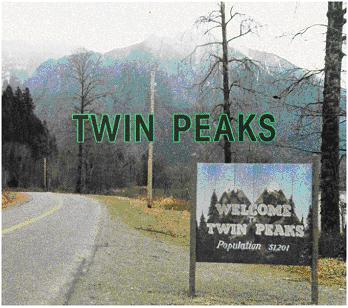
Twin Peaks and Its Influence on Contemporary American Television
In the spring of 1990, David Lynch and Mark Frost (co-directors and writers) introduced Twin Peaks as an eccentric artistic vision to bend the conventions of the traditional television drama narrative and establish a new cinematic visual style for television. Twin Peaks gained instant attention by viewers and critics, demonstrating that television doesnt have to be vapid entertainment. The television drama can provide a feasible venue for artistic expression of high-end filmic quality. Twin Peaks enjoyed an explosive and popular first season of quirky characters and unsolved mysteries. People hosted weekly Twin Peaks parties and universities (including UNC) presented seminars and panel forums to discuss the philosophy and mysteries of the series. Even trendy bars in Manhattan were claiming a slow down in business during the hours that Twin Peaks aired.
Using extreme close-ups, intricate dialogue, long takes, smooth editing, and a non-video recording style, Twin Peaks looked and sounded like no other series on television. This style introduced the trends of gothic television and postmodernism seen in later series such as The X-Files, Buffy the Vampire Slayer, CSI, Northern Exposure, and The Sopranos. The following sites discuss the influences of Twin Peaks on modern culture and television. To learn more about the Twin Peaks series and the artful film work of David Lynch, check out the sites below that detail the specifics of the television series and discuss the series influence on television and pop-culture.
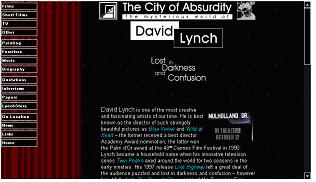
The City of Absurdity: The Mysterious World of David Lynch
http://www.geocities.com/Hollywood/2093/index.html
This site details the works of David Lynch and the Twin Peaks series, providing detailed series descriptions, cast interviews, reviews, articles, photos, episode screenplays, and academic theses on the influences and trends of the series. Reviews and articles include discussion about the series as it originally aired. In addition, the site provides links to academic theses written about the vision, influences, characters, and trends of the series.
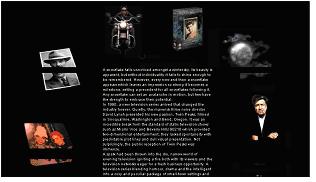
The Official Twin Peaks Site
http://www.cenedra.com/twinpeaksmain.htm
This site includes extensive information about David Lynch, cast lists, episode synopses, and character descriptions for the series. In addition to the basic series details, this site also provides discussion on the possible symbolism and theories hidden within the storylines. This site is perfect for the new viewer who would like to learn more about the series or find out how to get access to the series on DVD or Video. Although the DVD/Video page is under construction, the site provides other links and instructions for locating the series through Amazon. The site is also useful for the fan looking for a refresher on the series or an outlet for further discussion about the meaning of obscure plots and story arcs.
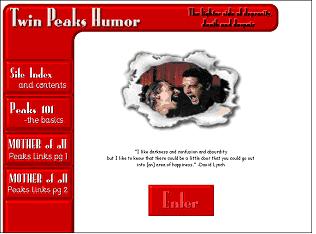
Twin Peaks Humor
http://www.geocities.com/Hollywood/Boulevard/1884/
The Twin Peaks Humor site serves as a portal for all Twin Peaks sites. This site provides helpful links to other Twin Peaks sites, extensive information about filming the series, various interviews with the actors, and episode reviews organized by character. The home page also provides some great comments about the influence of the series as quoted from reliable sources such as The New Yorker and various university commentaries.
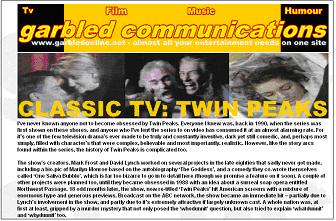
Garbled Communications: Classic TV: Twin Peaks
http://www.garbledonline.net/twinpeaks.html
Garbled Communications is an online magazine that provides commentary on television, film, music, and humor. This page provides a succinct yet comprehensive review of the Twin Peaks series and discusses public reactions and responses to the series. The article also discusses the artistic nature of the series and how the stylistic show invited other filmmakers such as Oliver Stone and Barry Levinson to the small screen. Lastly, the site provides a number of links that direct the reader to other Twin Peaks sites. Unfortunately, a few of those sites have phased out and are no longer accessible.

JAC: Twin Peaks and the Look of Television: Visual Literacy in the Writing Class
http://jac.gsu.edu/jac/13.2/Articles/10.htm
This online journal article is from JAC, an online forum that presents articles on pedagogical topics such as rhetoric, composition, and academic writing. This article is an excellent source of academic discussion about the influences and differentiators of Twin Peaks style and vision. The authors discuss how Twin Peaks visual techniques and camera usage were used artistically to make comment on the narrative. In addition, the article reviews the use of interrupted narrative and stylized mise en scene (atmosphere and art direction) to develop a rich drama unlike traditional television series such as Knots Landing, L.A. Law, and Happy Days. The article also provides an excellent Works Cited list that directs the reader to other sources that discuss the influences of the series.
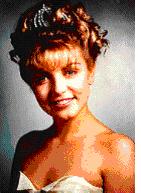
|

